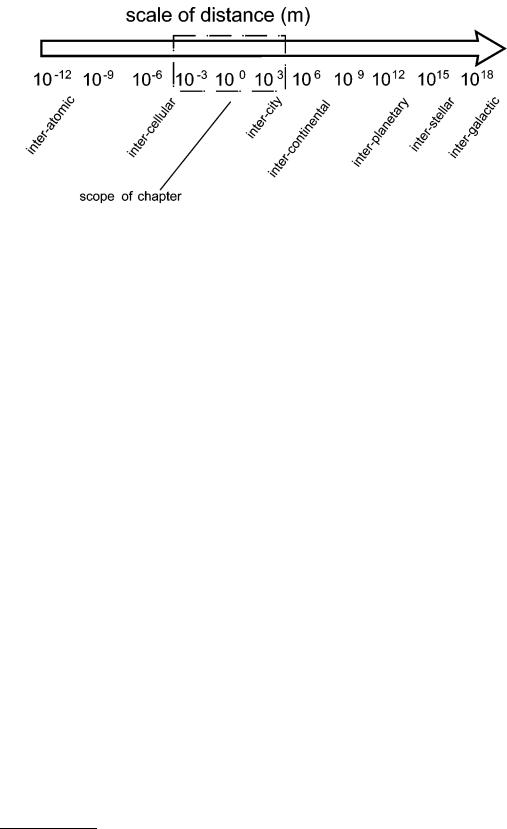
- •Distance
- •Contact or Noncontact
- •Active or Passive
- •Time-of-Flight, Triangulation, or Field Based
- •Time-of-Flight
- •Triangulation
- •Field-Based Approaches
- •Form of Energy
- •Sound
- •Stationary Magnetic Fields
- •Radio Frequencies
- •Light Frequencies
- •Coherent or Noncoherent Detection
- •Ranging, Range Imaging, or Position Tracking
- •9.2 Performance Limits of Ranging Systems
- •Range Accuracy
- •Depth of Field
- •Maximum Range
- •Lateral Resolution
- •Rate of Acquisition
- •Synchronized Scanning Principle
- •Light Plane Principle
- •Laser-Based Lidar Range Imaging Sensors
- •Resonating Lidar (Frequency-Based Detection)
- •Position Tracking with Active Targets
- •Active Target Triangulation
- •Magnetic Position Tracking
W. John Ballantyne. "Distance."
Copyright 2000 CRC Press LLC. <http://www.engnetbase.com>.

Distance
9.1Basic Distinctions Between Range Measurement
Techniques
Contact or Noncontact • Active or Passive • Time-of-Flight,
Triangulation, or Field Based • Form of Energy • Coherent or
Noncoherent Detection • Ranging, Range Imaging, or Position
Tracking
9.2Performance Limits of Ranging Systems
Range Accuracy • Depth of Field • Maximum Range • Lateral
Resolution • Rate of Acquisition
|
9.3 |
Selected Examples of Ranging, Range Imaging, and |
|
|
Motion Tracking Systems |
|
|
Laser-Based Active Triangulation Ranging and Range Imaging |
|
|
Sensors • Laser-Based Lidar Range Imaging Sensors • Position |
|
|
Tracking with Active Targets |
W. John Ballantyne |
9.4 |
A Sampling of Commercial Ranging, Range |
Spar Aerospace Ltd. |
|
Imaging, and Motion Tracking Products |
The tools and techniques of distance measurement are possibly one of humankind’s longest-running inventive pursuits. The scale shown in Figure 9.1 illustrates the enormous range of distances that science and engineering have an interest in measuring [1]. This chapter concerns itself with methods to measure a relatively small segment of this range — from centimeters to kilometers. Even within this limited segment, it would hardly be possible to list, much less describe, all of the distance measurement approaches that have been devised. Nevertheless, the small sampling of technologies that are covered here should be of help to a broad range of readers.
Distance measurement, at its most basic, is concerned with determining the length of a unidimensional line joining two points in three-dimensional space. Oftentimes, a collection of distance measurements is called for, so that the shape, the orientation, or the changes in position of an object can be resolved. Therefore, one must consider not only the measurement of distances, but also their spatial and temporal distributions. The terminology “ranging” will be used in reference to systems that perform single sensor- to-target measurements, “range-imaging” for systems that collect a dense map or grid of spatially distributed range measurements, and “position tracking” for systems that record the time history of distance measurement to one or several targets.
9.1Basic Distinctions Between Range Measurement Techniques
Range measurement devices may be classified according to some basic distinctions. Generalizations can be made based on these broad classes, thereby facilitating the process of comparison and selection. The following subsections identify the fundamental bases for classification.
© 1999 by CRC Press LLC

FIGURE 9.1 From the interatomic to the intergalactic, the range of measurable distances spans at least 30 orders of magnitude. The box outline indicates the relatively small segment that concerns this chapter.
Contact or Noncontact
A common approach to measuring the distance to a point on an object is through a calibrated mechanical device that simultaneously connects the selected point to a reference position. Any tape measure, feeler gage, or dial gage may be considered an example of a simple contacting measurement device. Mechanical/electronic devices are available that allow a user to “digitize” discrete point positions on a three-dimen- sional surface. A gimbaled probe on the end of an X-Y-Z positioner or articulated arm is used to touch a specific point, and sensory information of the linear positions or joint articulations provide an accurate position estimate. Mechanical, contact-based methods are widely used in industry and can be extremely accurate. Some coordinate measuring machines (CMMs), for example, can achieve 1 m repeatability.
The chief disadvantage of mechanical approaches is that they are usually restricted to distances and work volumes up to a few meters at maximum.This is due to fundamental scaling laws for mechanical structures. As the requirement to span larger distances increases, the mass and mechanical tolerancing requirements on the machine make designs impractical. Also, mechanical approaches are too slow to make multiple measurements in rapid succession, as is typically required in range imaging or position tracking, when the measurement involves large sets of spatially or temporally distributed data.
Noncontact techniques for performing ranging, range imaging, and position tracking are many and varied. Besl [2] reviews and compares several of these. In the centimeters to meters range, most do not approach the accuracy of CMMs; but at larger scales and for large quantities of data, they become a practical necessity. The rest of this chapter will review noncontact approaches only.
Active or Passive
Noncontact distance measurement may be divided into active or passive techniques. Active techniques involve some form of controlled energy (field or wave) linking a known reference location to the unknown target location. The source of energy is typically associated with the reference location, but in some cases the target, or both target and reference, may be active. Passive techniques rely on an externally occurring source of energy (e.g., sunlight or target/background temperature contrast) to make the target detectable.
An active approach can often simplify the distance measurement problem because it allows a greater degree of control over the many factors that can influence a measurement. For example, the choice of the form of energy and the power level of the active source can minimize the effect of uncontrolled variables like ambient illumination, weather, and atmospheric conditions. Furthermore, an active approach provides an opportunity to selectively localize the measurement spatially and temporally, eliminating possible ambiguity about which target point was measured at a given time. In contrast, passive
© 1999 by CRC Press LLC
